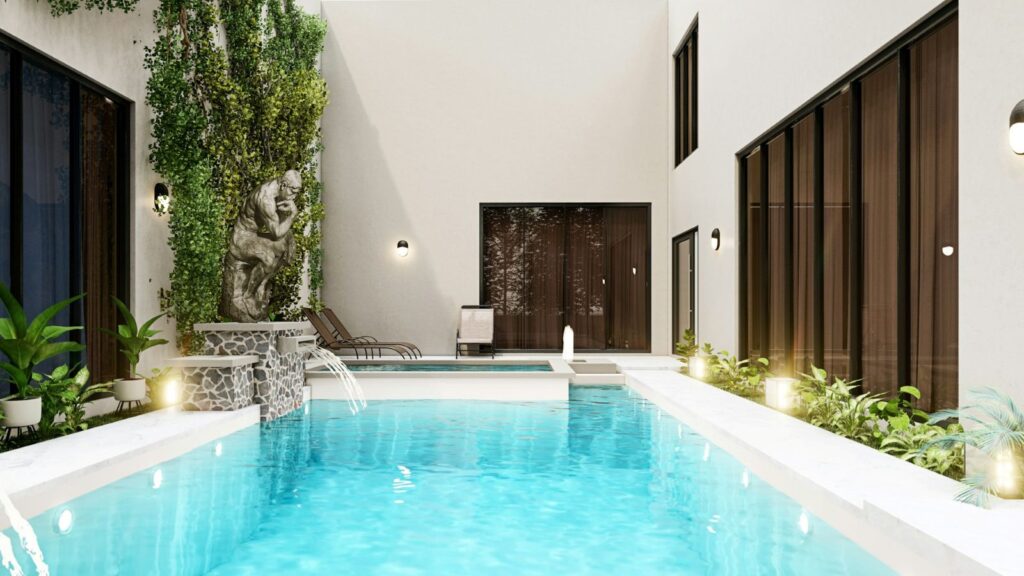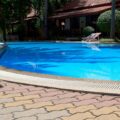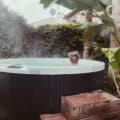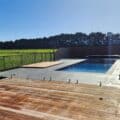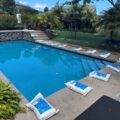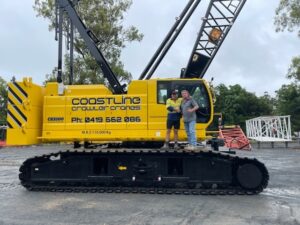Choosing between concrete pools and fibreglass pools for your Auckland home, usually comes down to how much control you as a homeowner wants over the final design and how long you expect the pool to remain a central feature of the property.
Concrete pools and fibreglass pools both provide enjoyable swimming environments, yet the underlying material, installation process, and adaptability of each option influence the long-term experience.
Concrete pools are built on site using reinforced concrete that cures into a solid structure, while fibreglass pools arrive as pre-formed shells that are lowered into an excavated area. This distinction shapes almost every other consideration, from design possibilities to durability and maintenance expectations.
How Material Composition Influences Durability and Longevity
Concrete pools are valued for structural strength, which comes from steel reinforcement and the density of the concrete itself. When properly engineered, they handle a wide range of environmental conditions, including soil movement and temperature fluctuations.
This makes concrete an appealing choice for homeowners who expect the pool to remain stable for several decades. Fibreglass pools rely on composite layers of resin and fibreglass, which are strong but not as structurally robust as reinforced concrete. Over time, gelcoat surfaces can lose lustre, particularly when exposed to harsh conditions or high levels of chemical imbalance.
Although fibreglass pools perform well for many years, their durability is partially tied to the quality of the factory mould and installation, leaving less flexibility for reinforcement during construction.
Installation Methods for Concrete Pools vs Fibreglass Pools
A major point of difference is the installation timeline. Concrete pools generally take longer because they are custom-built on site, requiring excavation, formwork, steel fixing, concreting, curing, and finishing. The benefit of this process is complete customisation, as every dimension and feature can be adjusted during construction.
Fibreglass pools offer faster installation, since the shell is manufactured elsewhere and installed as a single piece. The speed, however, comes with the trade-off of adhering to predetermined shapes and sizes. If the site has unusual contours or limited access, fibreglass shells may not be a feasible option, which often leads homeowners with challenging sections to favour concrete.
Cost Structures and Lifetime Value Across Both Pool Types
Initial costs vary, with fibreglass pools often offering a lower entry price and predictable installation costs. Concrete pools usually require a higher upfront investment due to their labour-intensive construction and tailored design. Yet the lifetime value of a concrete pool is often considered greater because the structure can be resurfaced, renovated, or redesigned without replacing the entire pool.
Fibreglass pools are more difficult to alter once installed, and significant wear or structural issues sometimes require shell replacement rather than refurbishment. For homeowners thinking long term, the ability to adapt and update a concrete pool can provide more substantial overall value.
Why Concrete Pools Offer Greater Customisation and Design Flexibility
Concrete pools are widely chosen for projects where individuality, creative control, and architectural cohesion matter. Their construction allows them to be shaped precisely to match the surrounding landscape or to reflect a homeowner’s personal preferences. This freedom is one of the strongest differentiators when comparing concrete pools vs fibreglass pools.
Shape, Size, and Depth Options Unique to Concrete Pools
Concrete pools can be engineered with deep ends, irregular shapes, sharp geometric lines, or organic curves. There is no reliance on existing moulds, so the design can be as modest or dramatic as required. This is useful for homeowners wanting lap pools with specific lengths, plunge pools fitted into small spaces, or family pools with varied depth profiles.
Fibreglass pools, in contrast, must conform to the dimensions of available shells. While modern fibreglass designs are improving, they still cannot match the near-limitless possibilities of concrete.
Integrating Concrete Pools Into Complex Landscapes or Sloped Sections
Challenging terrain can dictate which pool types are feasible. Concrete pools are particularly suited to sloped sites, narrow backyards, or areas with retaining walls. Because the structure is built in place, it can be adapted to achieve level surfaces or to form part of multi-layered outdoor living areas.
This flexibility is valuable in hillside suburbs or properties with tight boundaries. Fibreglass pools require enough access for machinery to deliver the shell and sufficient space to lower it safely into the excavation. When these conditions cannot be met, a concrete pool becomes the more practical and sometimes the only viable choice.
Finishes, Aesthetic Features, and Bespoke Architectural Elements
Concrete pools support a wide variety of finishes, ranging from plaster and aggregated surfaces to tiles. Tiling is often selected for premium projects because it allows for colour control, pattern variation, and cohesive integration with nearby flooring or landscaping.
Additional elements such as infinity edges, integrated spas, submerged benches, or architectural water features are easier to incorporate during the concrete build. Fibreglass pools offer fewer finishing options because the surface is part of the shell itself. Although some colours and textures are available, the level of personalisation remains more limited.
Performance and Maintenance: Concrete Pools vs Fibreglass Pools
The performance of a swimming pool over decades will depend on how well the material resists external forces and ongoing wear. Concrete and fibreglass both perform well in residential environments, yet their maintenance patterns are influenced by how they respond to chemicals, weather, and physical stress.
Structural Strength and Resilience in Variable Soil Conditions
Many homeowners opt for concrete pools when their land has reactive or unstable soils. Reinforced concrete provides the needed rigidity that helps the pool maintain its shape even when ground conditions change.
Fibreglass shells have some flexibility, which can be beneficial in mild conditions, but excessive movement can lead to surface cracking or warping. For long term reliability in unpredictable soil environments, concrete offers a more stable foundation.
Surface Maintenance, Repairs, and Renovation Cycles
Concrete pools typically require resurfacing at intervals, depending on the chosen finish and how well the pool has been maintained. These resurfacing projects provide an opportunity to update aesthetics or repair minor imperfections.
While fibreglass pools have less intensive maintenance demands initially, the gelcoat can become dull over time and may develop osmotic blistering. Repairing fibreglass surfaces can sometimes be noticeable, and refinishing the entire shell is a more complex exercise than the resurfacing options available to concrete pool owners.
How Fibreglass Limitations Compare With Concrete Adaptability
Fibreglass limitations tend to become more apparent as the pool ages or as a homeowner’s needs change. Because the shell cannot be easily reshaped or expanded, substantial alterations will rarely be cost-effective.
While concrete pools, however, can be modified in depth, extended in size, or upgraded with new structural or aesthetic elements. This adaptability is a key reason many homeowners view concrete pools as long term assets rather than fixed installations.
Home Value and Long Term Investment Considerations
A well designed pool can influence how a property is perceived in the Auckland market, particularly when it forms part of a cohesive outdoor space. Concrete pools and fibreglass pools both contribute to appeal, though their impact can differ based on material quality and potential longevity.
Perceived Quality and Lifespan of Concrete Pools in Residential Markets
Concrete pools are often associated with premium construction because they demonstrate craftsmanship, structural weight, and architectural intent. Their lifespan can also extend for many decades when they’re properly maintained, which enhances their appeal to prospective buyers looking for durable and stylish outdoor features.
Fibreglass pools also attract interest, though buyers may consider the age of the shell, the condition of the gelcoat, and the limited potential for redesign.
How Pool Type Influences Property Appeal and Valuation
Auckland property valuers and real estate agents frequently note that pools integrated into the overall landscape design carry greater weight in buyer decision making. Since concrete pools can be designed to complement surrounding entertainment areas, they often feel more permanent and cohesive.
Fibreglass pools can still add value, but their standardised shapes may not achieve the same architectural impact unless the landscape has been carefully coordinated around them.
Climate, Usage Patterns, and Material Performance Over Decades
Sunlight exposure, temperature shifts, and usage of your pool frequency influences its long term performance. Concrete pools can be engineered with more specific finishes and features suited to our local conditions, which improves its resilience.
Fibreglass pools offer good performance in milder climates but can show wear in regions such as Auckland with strong UV exposure or heavy use. Considering the pool’s lifespan relative to property ownership helps determine which option aligns with long term expectations.
Choosing the Best Pool for Your Home and Lifestyle
The decision between choosing concrete pools vs fibreglass pools hinges on priorities such as budget, timeframes, design control, and how the pool will be used. Both options will suit different homeowners, yet concrete pools hold a clear advantage when flexibility and long term value are central concerns.
When Concrete Pools Provide a Clear Advantage
Concrete pools stand out when homeowners require pools with unique shapes, custom depths, or more seamless integration with their complex outdoor environments. They also excel when long term resilience is important or when the homeowner expects to renovate the pool in future decades. The ability to add bespoke features further strengthens the case for concrete in projects where individuality and quality matter.
Situations Where Fibreglass May Still Be Suitable
Fibreglass pools remain a practical option for Auckland households wanting more predictable costs, faster installation, and straightforward maintenance early in the pool’s life. They suit standard sections with easy access and suit those homeowners who prefer a simple, pre-designed pool layout without any extensive customisation.
Balancing Budget, Personalisation, and Long Term Expectations
Budget obviously plays a crucial role when it comes to making a choice here, so weighing up the upfront costs against the lifetime value is absolutely essential. While concrete pools require a larger investment at the outset, their adaptability and longevity can justify the expense.
Auckland homeowners who prioritise quick installation and a lower initial spend may still find fibreglass appealing, provided they accept that it has limitations, including fixed sizing and design constraints.
Final Thoughts: What This Means for Homeowners
Concrete pools and fibreglass pools both deliver functionality as well as creating an enjoyable swimming environment, yet their differences become much more significant when considering the long term outcomes. Concrete pools offer unmatched customisation, enduring structural strength, and renovation possibilities that support changing lifestyle needs.
Fibreglass pools provide a reliable performance, but their standardised nature can often restrict the creative design and any future adaptability. For many homeowners in Auckland and across NZ, especially those thinking in terms of decades rather than years, the balanced durability and design freedom of concrete pools with a local Auckland pool builder make them a much more compelling choice for a lasting and integrated outdoor feature.



